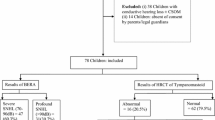Abstract
Purpose
The aim of the present study is to evaluate the auditory system in children affected by myelomeningocele and comparing the results with clinical neurological conditions.
Materials and methods
Forty-three children, aged between 7 and 26 years, affected by myelomeningocele were investigated by means of subjective tonal audiometry and objective impedance audiometry (tympanometry and acoustic stapedial reflex).
Results
Audiological evaluation showed an alteration in 32 patients (74 %%). Nine patients presented a mild hearing loss: bilateral in six cases (three sensorineural, one mixed, and two conductive) and unilateral in three cases (two mixed and one conductive). One patient had moderate unilateral conductive deafness and, finally another one severe unilateral sensorineural. Almost all patients with deafness were affected by myelomeningocele and Chiari II. Stapedial-cochlear reflex investigation showed an alteration in 30 patients (70 %): 9 of these also showed deafness while the remaining 21 was normal hearing. In these 30 patients, we demonstrated the presence of myelomeningocele, hydrocephalus, and Chiari II malformation in 21 subjects (70 %).
Conclusion
Otoneurological evaluation is important in myelomeningocele not only at the birth but also in the follow-up. It could have an important prognostic role for neurological impairment.
Similar content being viewed by others
Abbreviations
- MMC:
-
Myelomeningocele
- VEMPs:
-
Vestibular Evoked Myogenic Potentials
- EAEPs:
-
Early Auditory Evoked Potentials
- ASR:
-
Acoustic Stapedial Reflex
- UNHS:
-
Universal New-born Hearing Screening
References
Inchingolo R, Maresca G, Cacaci S, Ausili E, Paolucci V, Bonomo L, Romagnoli C, Rendeli C (2013) Post-natal ultrasound morpho-dynamic evaluation of mild fetal hydronephrosis: a new management. Eur Rev Med Pharmacol Sci 17(16):2232–2239
Rendeli C, Ausili E, Tabacco F, Caliandro P, Aprile I, Tonali P, Salvaggio E, Padua L (2005) Assessment of health status in children with spina bifida. Spinal Cord 43(4):230–235
Padua L, Rendeli C, Ausili E, Aprile I, Caliandro P, Tonali P, Salvaggio E (2004) Relationship between the clinical-neurophysiologic pattern, disability, and quality of life in adolescents with spina bifida. J Child Neurol 19(12):952–957
Picciotti PM, Fiorita A, Calò L, Battista M, Paolucci V, Ausili E, Massimi L, Rendeli C (2012) Vestibular evoked myogenic potentials in children affected by myelomeningocele. Childs Nerv Syst 28(10):1761–1765
Luigetti M, Losurdo A, Dittoni S, Testani E, Colicchio S, Gnoni V, Farina B, Scarano E, Zampino G, Mariotti P, Rendeli C, Di Rocco C, Massimi L, Della Marca G (2010) Improvement of obstructive sleep apneas caused by hydrocephalus associated with Chiari malformation Type II following surgery. J Neurosurg Pediatr 6(4):336–339
Fujii M, Tomita T, McLone DG, Grant JA, Mori K (1996) Natural course of brainstem auditory evoked potentials in infants less than 6 months old with asymptomatic meningomyelocele. Pediatr Neurosurg 25(5):227–232
Fujii M, Tomita T, McLone DG, Grant JA, Stack CV, Mori K (1997) Developmental normo-maturation of brainstem auditory evoked potentials in children with asymptomatic meningo-myelocele during the first year of life. Childs Nerv Syst 13(3):147–153
Worley G, Erwin CW, Schuster JM, Park Y, Boyko OB, Griebel ML, Weidman ER, Radtke RA, Oakes WJ (1994) BAEPs in infants with myelomeningocele and later development of Chiari II malformation-related brainstem dysfunction. Dev Med Child Neurol 36(8):707–715
Nishimura T, Mori K, Uchida Y, Ohira T, Tamura K (1991) Brain stem auditory-evoked potentials in meningomyelocele. Natural history of Chiari II malformations. Childs Nerv Syst 7(6):316–326
Mori K, Nishimura T (1995) Electrophysiological studies on brainstem function in patients with myelomeningocele. Pediatr Neurosurg 22(3):120–131
Lütschg J, Meyer E, Jeanneret-Iseli C, Kaiser G (1985) Brainstem auditory evoked potentials in meningomyelocele. Neuropediatrics 16(4):202–204
Liu XZ, Pandya A, Angeli S, Telischi FF, Arnos KS, Nance WE, Balkany T (2005) Audiological features of GJB2 (connexin 26) deafness. Ear Hearing 26:361–369
Taylor MJ, Boor R, Keenan NK, Rutka JT, Drake JM (1996) Brainstem auditory and visual evoked potentials in infants with myelomeningocele. Brain Dev 18:99–104
Paludetti G, Conti G, DI Nardo W, DE Corso E, Rolesi R, Picciotti PM, Fetoni AR (2012) Infant hearing loss: from diagnosis to therapy Official Report of XXI Conference of Italian Society of Pediatric Otorhinolaryngology. Acta Otorhinolaryngol Ital 32(6):347–370
Satzer D, Guillaume DJ (2014) Prognostic value of newborn hearing screening in patients with myelomeningocele. J Neurosurg Pediatr 14(5):495–500
Vinck A, Nijhuis-van der Sanden MW, Roeleveld NJ, Mullaart RA, Rotteveel JJ, Maassen BA (2010) Motor profile and cognitive functioning in children with spina bifida. Eur J Paediatr Neurol 14(1):86–92
Dennis M, Barnes MA (2010) The cognitive phenotype of spina bifida meningomyelocele. Dev Disabil Res Rev 16(1):31–39
Koehler J, Schwarz M, Boor R, Hölker C, Hopf HC, Voth D, Urban PP, Ermert A (2000) Assessment of brainstem function in Chiari II malformation utilizing brainstem auditory evoked potentials (BAEP), blink reflex and masseter reflex. Brain Dev 22(7):417–420
Nishimura T, Mori K (1996) Blink reflex in meningomyelocele, with special reference to its usefulness in the evaluation of brainstem dysfunction. Childs Nerv Syst
Financial disclosure
This work has no financial support.
The authors do not have any financial interest in companies or other entities that have an interest in the information in the contribution.
Conflict of interest
The authors declare that they have no conflict of interest.
Author information
Authors and Affiliations
Corresponding author
Rights and permissions
About this article
Cite this article
Picciotti, P.M., Battista, M., Pandolfini, M. et al. Audiological evaluation in children affected by myelomeningocele. Childs Nerv Syst 31, 2321–2324 (2015). https://doi.org/10.1007/s00381-015-2898-9
Received:
Accepted:
Published:
Issue Date:
DOI: https://doi.org/10.1007/s00381-015-2898-9




